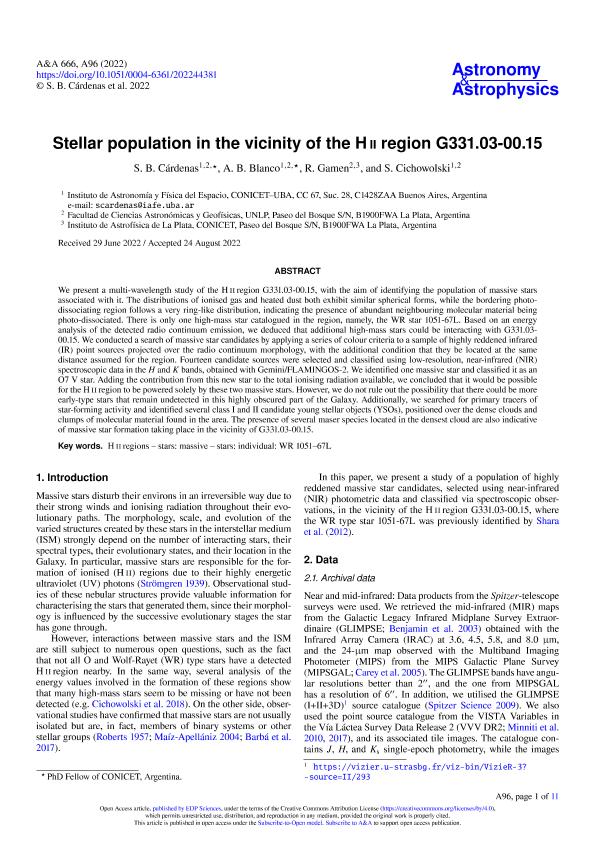Mostrar el registro sencillo del ítem
dc.contributor.author
Cárdenas, Silvina Belén

dc.contributor.author
Blanco, Agustina Belen

dc.contributor.author
Gamen, Roberto Claudio

dc.contributor.author
Cichowolski, Silvina

dc.date.available
2023-10-04T15:36:43Z
dc.date.issued
2022-10
dc.identifier.citation
Cárdenas, Silvina Belén; Blanco, Agustina Belen; Gamen, Roberto Claudio; Cichowolski, Silvina; Stellar population in the vicinity of the H ii region G331.03-00.15; EDP Sciences; Astronomy and Astrophysics; 666; 10-2022; 1-11
dc.identifier.issn
0004-6361
dc.identifier.uri
http://hdl.handle.net/11336/214095
dc.description.abstract
We present a multi-wavelength study of the H ii region G331.03-00.15, with the aim of identifying the population of massive stars associated with it. The distributions of ionised gas and heated dust both exhibit similar spherical forms, while the bordering photo-dissociating region follows a very ring-like distribution, indicating the presence of abundant neighbouring molecular material being photo-dissociated. There is only one high-mass star catalogued in the region, namely, the WR star 1051-67L. Based on an energy analysis of the detected radio continuum emission, we deduced that additional high-mass stars could be interacting with G331.03-00.15. We conducted a search of massive star candidates by applying a series of colour criteria to a sample of highly reddened infrared (IR) point sources projected over the radio continuum morphology, with the additional condition that they be located at the same distance assumed for the region. Fourteen candidate sources were selected and classified using low-resolution, near-infrared (NIR) spectroscopic data in the H and K bands, obtained with Gemini/FLAMINGOS-2. We identified one massive star and classified it as an O7 V star. Adding the contribution from this new star to the total ionising radiation available, we concluded that it would be possible for the H ii region to be powered solely by these two massive stars. However, we do not rule out the possibility that there could be more early-type stars that remain undetected in this highly obscured part of the Galaxy. Additionally, we searched for primary tracers of star-forming activity and identified several class I and II candidate young stellar objects (YSOs), positioned over the dense clouds and clumps of molecular material found in the area. The presence of several maser species located in the densest cloud are also indicative of massive star formation taking place in the vicinity of G331.03-00.15.
dc.format
application/pdf
dc.language.iso
eng
dc.publisher
EDP Sciences

dc.rights
info:eu-repo/semantics/openAccess
dc.rights.uri
https://creativecommons.org/licenses/by/2.5/ar/
dc.subject
H II REGIONS
dc.subject
STARS: INDIVIDUAL: WR 1051-67L
dc.subject
STARS: MASSIVE
dc.subject.classification
Astronomía

dc.subject.classification
Ciencias Físicas

dc.subject.classification
CIENCIAS NATURALES Y EXACTAS

dc.title
Stellar population in the vicinity of the H ii region G331.03-00.15
dc.type
info:eu-repo/semantics/article
dc.type
info:ar-repo/semantics/artículo
dc.type
info:eu-repo/semantics/publishedVersion
dc.date.updated
2023-09-05T18:02:45Z
dc.journal.volume
666
dc.journal.pagination
1-11
dc.journal.pais
Francia

dc.journal.ciudad
Paris
dc.description.fil
Fil: Cárdenas, Silvina Belén. Consejo Nacional de Investigaciones Científicas y Técnicas. Oficina de Coordinación Administrativa Ciudad Universitaria. Instituto de Astronomía y Física del Espacio. - Universidad de Buenos Aires. Facultad de Ciencias Exactas y Naturales. Instituto de Astronomía y Física del Espacio; Argentina. Universidad Nacional de La Plata. Facultad de Ciencias Astronómicas y Geofísicas; Argentina
dc.description.fil
Fil: Blanco, Agustina Belen. Consejo Nacional de Investigaciones Científicas y Técnicas. Oficina de Coordinación Administrativa Ciudad Universitaria. Instituto de Astronomía y Física del Espacio. - Universidad de Buenos Aires. Facultad de Ciencias Exactas y Naturales. Instituto de Astronomía y Física del Espacio; Argentina. Universidad Nacional de La Plata. Facultad de Ciencias Astronómicas y Geofísicas; Argentina
dc.description.fil
Fil: Gamen, Roberto Claudio. Consejo Nacional de Investigaciones Científicas y Técnicas. Centro Científico Tecnológico Conicet - La Plata. Instituto de Astrofísica La Plata. Universidad Nacional de La Plata. Facultad de Ciencias Astronómicas y Geofísicas. Instituto de Astrofísica La Plata; Argentina. Universidad Nacional de La Plata. Facultad de Ciencias Astronómicas y Geofísicas; Argentina
dc.description.fil
Fil: Cichowolski, Silvina. Consejo Nacional de Investigaciones Científicas y Técnicas. Oficina de Coordinación Administrativa Ciudad Universitaria. Instituto de Astronomía y Física del Espacio. - Universidad de Buenos Aires. Facultad de Ciencias Exactas y Naturales. Instituto de Astronomía y Física del Espacio; Argentina. Universidad Nacional de La Plata. Facultad de Ciencias Astronómicas y Geofísicas; Argentina
dc.journal.title
Astronomy and Astrophysics

dc.relation.alternativeid
info:eu-repo/semantics/altIdentifier/url/https://www.aanda.org/articles/aa/full_html/2022/10/aa44381-22/aa44381-22.html
dc.relation.alternativeid
info:eu-repo/semantics/altIdentifier/doi/https://doi.org/10.1051/0004-6361/202244381
Archivos asociados
